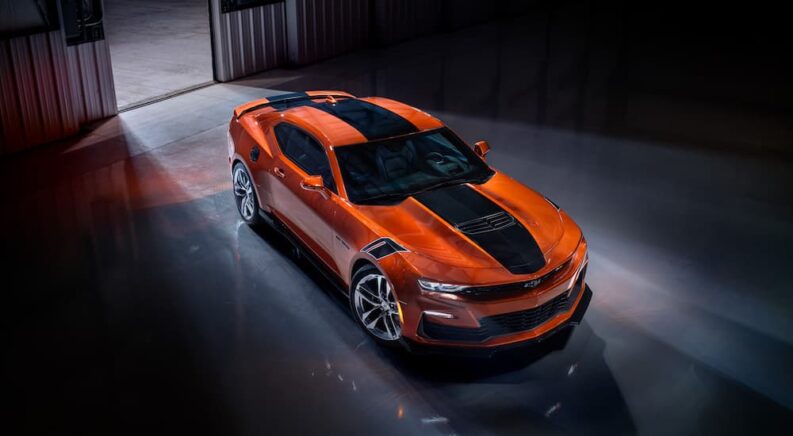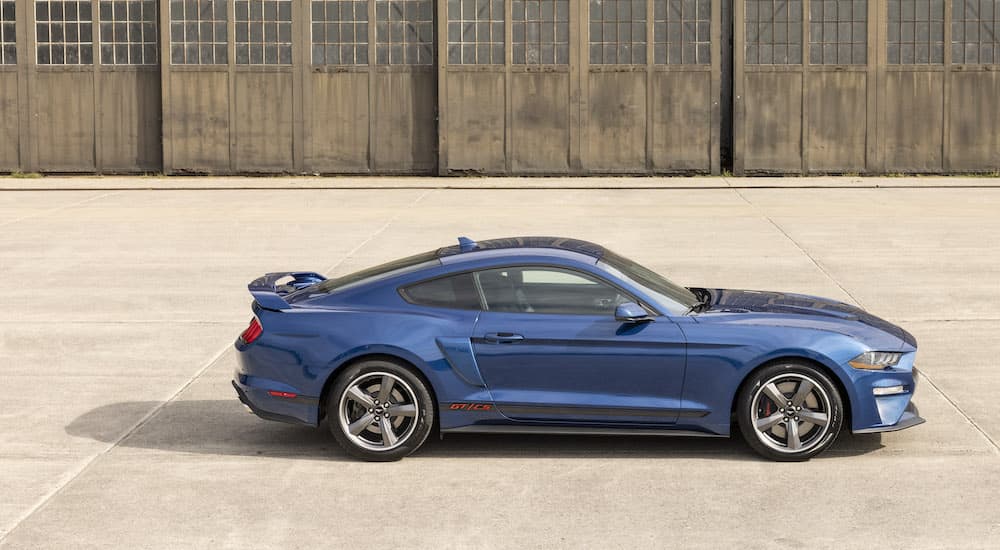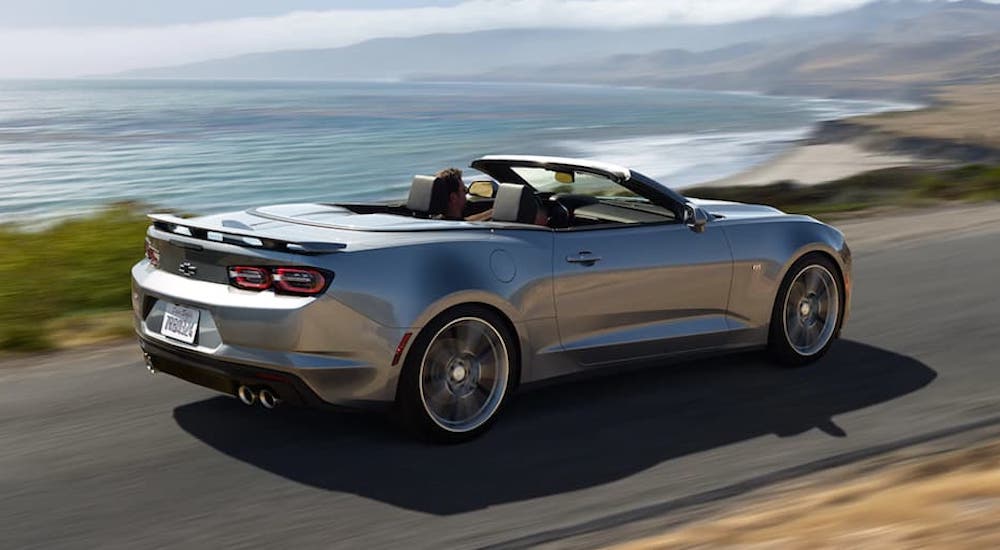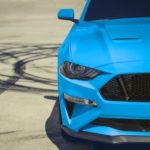The pony car is a uniquely American invention, perfectly capturing the nation’s spirit with its brash, sporty design and thrill-seeking attitude. Marked by its distinctive long hood and short deck design, the pony car originated as an experiment in repurposing mass-produced parts from existing models into an entirely new type of vehicle that brought a fresh, fun, and youthful vibe to the lineup. The pony car rose to popularity in the mid-60s with the debut of the Ford Mustang; the so-called “original” pony car (more on that later) was conceived with a simple goal in mind: capitalizing on the demand for small, fun-to-drive, affordable cars that would appeal to a new generation of young drivers.
When it comes to comparing two of the category’s long-standing favorites, the 2023 Chevy Camaro vs 2023 Ford Mustang, it’s useful to take a step back and see how these two models came to be—so join us as we explore the history of these two models and compare the most recent iterations of two American auto giants.
Inventing a Classic
While the Mustang is often credited with inventing the pony car category—and gracing it with its stallion-inspired name—it was actually beaten to market by the Plymouth Barracuda, a fastback coupe version of the Plymouth Valiant compact car that debuted two weeks before Ford’s pony. Unfortunately for Plymouth, the term “fish car” doesn’t inspire much confidence, so credit has largely gone to the Mustang.
In truth, neither Ford nor Plymouth can lay claim to the title as the concept stretches back to the beginning of the decade, when Chevrolet introduced the 1960 Corvair. Marketed as an economy car, the Corvair’s sporty Monza trim would provide a prototype for all pony cars to come with its bucket seats, floor-mounted shifter, and bold design. After the Mustang hit the streets in 1965, the pony car formula started to coalesce into a new class all its own, defined by a few simple attributes: a compact car with a long hood, short deck, seating for four, endless customization options, youth-oriented marketing, and—most importantly—a low starting price. The Mustang retailed for just over $20,000 when it was introduced, putting this alluring new model well within reach of many younger drivers.
The brainchild of famed automotive executive Lee Iacocca, the Mustang started as a sporty four-seater based on the existing Ford Falcon platform. Available as either a two-door coupe or convertible, the Mustang might have looked every bit the sporty racer but kept the starting price low by packing a standard-issue economy car powertrain under the hood. The 1965 Mustang was powered by a relatively underwhelming 2.8L six-cylinder engine paired with a three-speed manual transmission, but the fledgling model was buoyed by its nearly endless customization potential. The Mustang could be optioned with a V8 engine, four-speed manual transmission, power steering, and more, making it easy for drivers to find a model that fit their unique needs and budget. Ford’s pony car was an overnight success, selling 22,000 units on its first day and more than 618,000 over the first year.
Those sorts of numbers are hard to ignore, inspiring competitors to come for the newly minted pony car crowd in short order. Chevy tried to restyle the 1965 Corvair to fit in with the new craze but saw the writing on the wall and started over from scratch. Codenamed “Panther,” Chevy’s first true pony car shared the Chevy Nova’s GM F-body platform and featured the same conventional rear-drive, front-engine configuration found on the Mustang. Like the Mustang, the Camaro was sold as either a two-door coupe or convertible and came standard with a 3.8L six-cylinder engine, along with a host of larger six-cylinder engines as well as a V8 option. Available in Super Sport and Rally Sport trims, the original Camaro was complemented by a high-performance Z/28 variant in late 1966.
When it was eventually released to the public, “Panther” had transformed into “Camaro,” a unique name that a Chevy spokesperson said was inspired by “friend, pal, or comrade.” While that’s a very feel-good etymology, we prefer the version credited to an anonymous Chevy sales executive who claimed the Camaro was “a small, vicious animal that eats Mustangs.” This quip would set the stage for a rivalry that continues to this day, with the Chevy Camaro and Ford Mustang remaining the two biggest names in the ever-shrinking world of pony cars.
Head-to-Head
Even after almost 60 years on the market, the Chevy Camaro and Ford Mustang are still locked in a neck-in-neck battle for pony car supremacy, and the 2023 models prove just how close the race remains. Both come standard with a four-cylinder engine and optional V8s. Both continue to be offered in both convertible and coupe body styles that seat four passengers, and both are offered in alluring high-performance variants that allow drivers to truly test their limits. While it largely comes down to a matter of taste, we thought it would be a useful exercise to see how the two models stack up when it comes to performance and features.
Performance
The 2023 Chevy Camaro is available with four distinct engine options, starting with a four-cylinder, 275-hp setup. That might seem like a downgrade from the pony car’s original V6 engine, right up until you factor in the included turbocharger. With a little forced induction added to the mix, the turbocharged four-cylinder boasts 295 lb-ft of torque and can race from zero to sixty in just 5.4 seconds in a coupe model with a manual transmission. It’s a great starting point for the Camaro, but those seeking a little more power should look into the available V6, which offers an impressive 335 hp along with a satisfying growl that’s sure to turn some heads.
With a zero-to-sixty time of 5.2 seconds, the V6 is a great, well-rounded option that can be optioned with a ten-speed automatic transmission with race-ready paddle shifters. Chevy rounds out the Camaro’s engine lineup with two V8 options: a standard 6.2L setup and a turbocharged version that delivers the ultimate in driving performance. When paired with the ten-speed automatic transmission, the regular V8 is good for 445 hp and a zero-to-sixty time of just 4.0 seconds. The supercharged V8 ups the power to a rubber-burning 650 hp, rocketing the Camaro from zero to sixty in a scant 3.5 seconds.
The Mustang offers a similar lineup of four available engines for 2023, though Ford has nixed the V6 in favor of two turbocharged four-cylinder options. The base model comes with a 2.3L EcoBoost engine delivering 310 hp and 350 lb-ft of torque, but it doesn’t really manage to improve on the Camaro’s zero-to-sixty time despite the extra 15 horses. When optioned with the High-Performance package, the four-cylinder EcoBoost adds 20 hp—but that, too, doesn’t seem to have a noticeable effect on acceleration.
Instead of a V6, the Mustang jumps straight into V8 territory with two 5.0L options. The V8 found on the GT model is good for 450 hp and 410 lb-ft of torque, while the top-tier Mach 1 model offers even more horsepower, good enough for a zero-to-sixty time of 4.2 seconds—although that still lags behind the Camaro’s own high-end V8 by a considerable margin.
All in all, both models have all the power the average driver could ask for—but if you’re the type of driver who measures their fun by specs and specs alone, the Camaro seems to have a slight edge on the upper end while the Mustang packs more of a punch when it comes to the entry-level models.
Features
Traditionally, pony cars tended to focus more on what’s under the hood than all the bells and whistles one might find in the other classes. This has changed over the decades as consumer tastes and demands have evolved, leading to a new generation of pony cars that are just as well-equipped as the rest of the lineup. Don’t believe us? Just take one look inside the 2023 Chevy Camaro.
This model features a decidedly modern look with customizable ambient interior lighting and a futuristic heads-up display that is nowhere to be found on the Mustang. That’s not to say that Ford’s contender is lagging too far behind—the Mustang includes a number of premium features such as heated and cooled front seats, decent cargo space, and easily stowable back seats—but Ford has relied a little too heavily on plastic throughout its interior, lending this pony car a less-than-premium feel. Drivers don’t flock to the category for spacious rear seating, but Ford had made the back row even less practical by failing to include headrests, which is a confusing and potentially dangerous decision on the part of the Big Blue Oval.
On the infotainment front, the two models are relatively well-matched. Both come with all the connectivity options one could ask for, including Apple CarPlay, Android Auto, and a Wi-Fi hotspot. The biggest difference comes down to how drivers interact with those systems. Serving as a one-stop shop for everything from navigation and entertainment to safety systems, relevant vehicle metrics, and more, infotainment screens have become increasingly important to drivers in recent years.
This makes Ford’s decision to grace its flagship pony car with a measly 4.0-inch screen all the more confusing. Sure, drivers who opt for the Mustang’s Premium and Mach 1 trim will see that upgraded to a decent 8.0 inches, but the standard display is almost laughably small for the year 2023. The Camaro, on the other hand, comes standard with a 7.0-inch display that can be upped to 8.0 inches on the 1LT, 2LT, and 3LT trims.
The Camaro does trail the Mustang when it comes to fuel economy, posting a combined city/highway rating of 22 MPG to the Ford’s 24 MPG, but it makes up the difference with a larger gas tank. The Camaro’s tank is almost 25% larger than the one found on the Mustang, giving drivers an estimated range of 361 city/532 highway miles compared to the Mustang at 326 city/450 highway. That extra range can make all the difference on longer rides, allowing drivers to enjoy life behind the wheel of a classic American pony car without constantly being on the lookout for the next gas station.
While both models are built with similar proportions, the Camaro is a bit longer, with a wheelbase of 110 inches, versus the Mustang at 107 inches. Those three inches can be important in high-speed racing scenarios where more distance between the front and rear tires equates to more stability and, in turn, better performance. The Camaro is also going to be the more comfortable option for taller drivers, with more front-row headroom than Ford’s offering.
Unleash the Beasts
Pony cars like the 2023 Chevy Camaro and 2023 Ford Mustang are two great options for drivers seeking a taste of high-speed fun without breaking the bank. These affordable, exciting rides might have started out as youth-oriented models with an emphasis on style over substance, but they’ve matured into something a little more refined over the last 50-plus years.
Luckily some things haven’t changed. Models like the Camaro and Mustang are still as customizable as ever, allowing drivers to build their own dream racer from the ground up with a variety of engine options, equipment packages, and trims to choose from. While these two models are pretty well-matched in most categories, the Camaro does take the edge in some important areas. Case in point: the 2016 Camaro—the first model year of the current sixth generation—was named Motor Trend’s Car of the Year in 2016.
In the end, it all comes down to what a driver is looking for—but one thing’s for sure: one ride in either of these models and you’re sure to develop an insatiable taste for speed.






